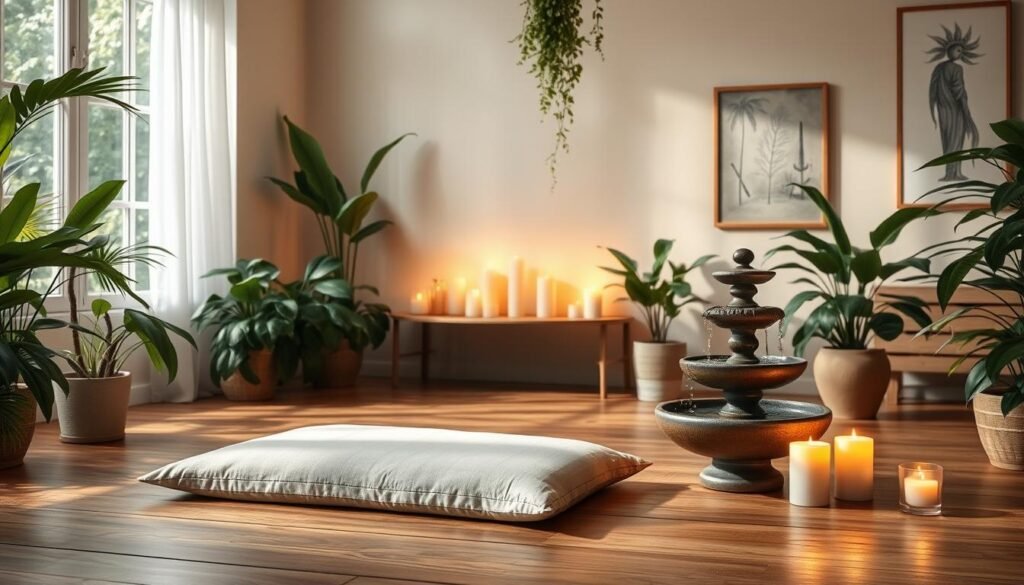Did you know over 14% of American adults meditate regularly? This number has tripled in ten years. It shows a growing need for stress management and mental well-being in our fast world. We’ll look at simple yet powerful meditation techniques to help you find inner peace.
Key Takeaways
- Discover the fundamentals of mindfulness practice and how it differs from regular thinking
- Learn about the science-backed benefits of meditation for physical and mental health
- Master essential meditation techniques for beginners, including breath awareness and body scanning
- Explore advanced practices like mantra meditation and loving-kindness for emotional balance
- Create the perfect meditation environment to support your daily practice
Understanding the Basics of Mindfulness Practice
In today’s fast world, it’s easy to feel overwhelmed. Our minds are always racing with thoughts and worries. But, there’s an ancient practice that can bring us peace and clarity – mindfulness.
What Makes Mindfulness Different from Regular Thinking?
Mindfulness is more than just thinking. It’s about being fully present in the moment. Unlike our usual mind state, where we often dwell on the past or worry about the future, mindfulness teaches us to observe without judgment. This awareness is key to unlocking mindfulness’s benefits.
The Science Behind Mindfulness Benefits
Studies show that mindfulness can greatly improve our mental, emotional, and physical health. It can reduce stress and anxiety, improve focus, and even change our brain structure. This includes more gray matter in areas linked to learning and memory.
Getting Started with Mindfulness
Starting a mindfulness practice is simple. Here are a few tips to begin:
- Take a few minutes each day to sit quietly and focus on your breath. Start with 5-10 minutes and increase as you get more comfortable.
- When your mind wanders, gently bring your focus back to your breath without judgment.
- Try different mindfulness exercises, like body scans or loving-kindness meditation, to find what suits you best.
- Be patient and kind to yourself. Mindfulness takes time to master.
Consistent practice is the key to unlocking mindfulness exercises and meditation techniques. Even a small daily investment can lead to transformative benefits.
Essential Meditation Techniques for Beginners
Meditation is a journey to inner peace and clarity. For beginners, there are key techniques to start with. Let’s explore some easy and effective methods for beginners.
Breath Awareness Meditation
Breath awareness is a simple yet powerful technique. It involves focusing on your natural breathing. By focusing on your breath, you can find calm and be present in the moment.
Body Scan Meditation
The body scan meditation is another great technique for beginners. It relaxes your body from toes to head. As you focus on each part, you release tension and feel well.
Mindfulness Exercises
Mindfulness exercises are easy to add to your day. They involve noticing your senses, like food taste or ground feel. They help you stay calm and clear, even in busy times.
Consistency is key in meditation. Start with short sessions and grow as you get more comfortable. With effort, these techniques can deepen your self-awareness and connection to the world.

The Power of Breath Awareness in Daily Practice
Breath awareness is a key tool in meditation and mindfulness. It helps us find calm and inner peace. We’ll look at different breathing patterns for relaxation, how to add them to our daily life, and solve common challenges.
Different Breathing Patterns for Relaxation
There are many breathing techniques, each with its own benefits. Diaphragmatic breathing, or “belly breathing,” lowers stress and relaxes us. Alternate nostril breathing balances and stabilizes us. Resonant breathing slows down our heart and blood pressure.
Incorporating Breath Work into Your Routine
To fully benefit from breath awareness, make it a regular part of your life. Spend a few minutes each morning, take breaks during the day, or include it in your meditation. This can greatly improve your well-being.
Troubleshooting Common Breathing Challenges
- Difficulty focusing on the breath: Try using a breath counting technique or visualizing the flow of air.
- Feeling self-conscious: Remember that breath awareness is a personal journey; there’s no right or wrong way to do it.
- Experiencing restlessness or discomfort: Adjust your posture or try a different breathing pattern until you find what works best for you.
Embracing breath awareness is a powerful step towards cultivating meditation techniques and inner peace. By exploring various breathing patterns, incorporating them into your daily life, and addressing any challenges that arise, you can unlock the transformative benefits of this profound practice.

Creating Your Perfect Meditation Space
Creating a dedicated meditation space can greatly improve your meditation techniques and mindfulness exercises. By designing your surroundings carefully, you can make an environment that helps you focus, relax, and explore your inner self.
Begin by picking a quiet spot in your home, away from busy areas and distractions. Think about natural light, temperature, and noise to make sure your space is comfy and good for meditation.
- Choose soft, indirect lighting like candles or dimmer lamps for a calming feel.
- Add plants or natural fibers to bring a sense of calm and connection to nature.
- Keep things simple and clutter-free to keep your space peaceful and focused.
Comfort is crucial, so get a good cushion, mat, or chair for your meditation. Try out different options to see what feels best for you.
| Meditation Cushion Types | Advantages |
|---|---|
| Zafu (round cushion) | Provides elevation and support for the spine |
| Meditation bench | Allows for a more upright posture and reduces pressure on the legs |
| Yoga mat | Offers a stable and comfortable surface for seated or lying meditations |
The aim is to make a space that’s calming, welcoming, and free from distractions. This way, you can dive deep into your meditation techniques and mindfulness exercises.
“The space in which we place ourselves has a profound impact on our state of mind and the quality of our practice.”

Body Scan Meditation: A Gateway to Deep Relaxation
Discover the power of body scan meditation. It’s a mindfulness exercise that leads to deep relaxation and self-awareness. This technique helps you focus inward, scanning your body for present-moment awareness.
Step-by-Step Body Scanning Process
Start by sitting or lying down comfortably. Focus on your breath first. Then, slowly move your attention up your body, noticing any sensations without judgment.
Begin with your toes and move up to your feet, legs, and abdomen. Continue to your chest, arms, hands, and head.
Benefits of Regular Body Scanning
Regular body scan meditation brings many benefits. It can lower stress and anxiety, promote relaxation, and improve well-being. It helps you become more aware of your body and emotions.
Common Experiences During Body Scan
During the body scan, you might feel different sensations. Some people feel heaviness or lightness, while others notice tingling or warmth. These feelings are part of the process and offer insights into your state.
See body scan meditation as a way to find deep relaxation and self-discovery. By practicing this mindfulness exercise, you can find inner peace and connect with your body and mind.

Walking Meditation: Mindfulness in Motion
In today’s fast world, it’s easy to get lost in our thoughts. But walking meditation offers a way out. It’s a form of mindfulness exercises that helps us stay present and connected to our bodies and surroundings.
Walking meditation blends walking with focused attention. It’s different from sitting meditation. Here, you focus on each step, your breath, and the world around you as you move.
- Find a quiet, open space for walking without distractions.
- Stand still, breathe deeply, and settle your body and mind.
- As you walk, notice your body’s sensations – legs moving, feet touching the ground.
- Walk at a steady pace, keeping your eyes slightly down to avoid distractions.
- Breathe naturally, feeling the rhythm of your breath.
- If your mind wanders, gently bring it back to the present and your walking.
Walking meditation offers many benefits. It can lower stress and anxiety, improve focus, and bring peace and well-being. Adding it to your daily routine can help you appreciate the present moment, wherever you go.

“Walking meditation is a powerful way to connect with the present moment and find a sense of inner calm, even in the midst of a busy life.”
Mantra Meditation: Using Sound for Inner Peace
Mantra meditation involves repeating a specific word or phrase. It’s a powerful tool for finding inner peace and focus. This ancient method uses sound to guide you towards mindfulness and self-awareness.
Choosing Your Personal Mantra
Start by picking a word or phrase that means something to you. It could be a traditional Sanskrit mantra, a phrase in your language, or even “Om.” Choose something that feels comforting and meaningful to you.
- Explore different mantras and their meanings to find one that aligns with your spiritual or personal beliefs.
- Consider a mantra that reflects your intention, such as “peace,” “love,” or “clarity.”
- Experiment with different sounds and rhythms until you find a mantra that feels right for you.
Incorporating Mantras into Practice
After picking your mantra, add it to your meditation routine. Set aside a few minutes each day to sit quietly. Focus on repeating your mantra as you breathe deeply.
As you practice, your mantra can become a powerful tool for inner peace and clarity. By regularly using your mantra, you can train your mind to stay present and let go of distractions.

“The repetition of a mantra can be a powerful way to focus the mind and access deeper states of consciousness.”
Loving-Kindness Meditation for Emotional Balance
In today’s fast world, it’s easy to forget about our emotional health. But loving-kindness meditation can help. It teaches us to be kind to ourselves and others.
This meditation, also known as metta, focuses on spreading kindness. We start with ourselves and then move to those we care about, even strangers. It helps us feel more connected and balanced.
- Find a quiet spot to sit and close your eyes. Take a few deep breaths to calm down.
- Start by wishing kindness to yourself. Imagine warmth around you and say “May I be happy, healthy, and at peace.”
- Then, think of someone you love, a neutral person, and even someone you might not get along with. Say the same wish, but change “I” to “you” for each.
- End by wishing kindness to everyone, hoping they are all happy and free from pain.
Doing loving-kindness meditation regularly can make us feel happier and less stressed. It also helps our bodies stay healthy. By being kind, we improve our relationships and our own well-being.
“Darkness cannot drive out darkness; only light can do that. Hate cannot drive out hate; only love can do that.” – Martin Luther King Jr.
Starting loving-kindness meditation can change your life. It helps us be more empathetic and strong emotionally. Try it and see how it can positively affect your life.

Progressive Muscle Relaxation Techniques
Progressive muscle relaxation is a great addition to your meditation routine. It involves tensing and then relaxing different muscle groups. This helps you feel deeply relaxed both physically and mentally.
Physical Benefits of Muscle Relaxation
Progressive muscle relaxation can ease physical discomfort and muscle stiffness. It’s especially helpful for those with stress-related aches or pains. It can help loosen tightness in the neck, shoulders, or back.
Mental Impact of Progressive Relaxation
This technique also benefits your mental state. It helps you focus inward and become more aware of your body. This can lead to a calm state of mind, lower anxiety, and improve your emotional health.
FAQ
What makes mindfulness different from regular thinking?
Mindfulness is about being aware in the moment without judgment. It’s different from our usual thoughts and distractions. It lets us see our experiences openly and accept them.
What are the benefits of mindfulness practice?
Studies show mindfulness lowers stress and boosts focus. It also helps manage emotions and improves health. It can strengthen your immune system and reduce inflammation.
How can I get started with mindfulness practice?
Begin by dedicating a few minutes each day to mindfulness exercises. Start with focusing on your breath or a body scan. As you get more comfortable, increase the time you practice.
What are some essential meditation techniques for beginners?
Beginners should try breath awareness, body scan meditation, and basic mindfulness exercises. These techniques help you stay present and build skills for more advanced meditations.
How can I incorporate breath awareness into my daily routine?
Use reminders to pause and focus on your breath throughout the day. Try different breathing patterns to relax and clear your mind.
What is the purpose of body scan meditation?
Body scan meditation relaxes you by focusing on your body from head to toe. It helps release tension and connect with your body’s sensations.
How do I practice walking meditation?
Walking meditation slows down your pace and focuses on body sensations. Notice your feet touching the ground and your breath’s rhythm.
What is the purpose of using a mantra in meditation?
Mantra meditation uses a word or sound to focus the mind and find peace. A personal mantra can deepen your practice and keep you present.
How can I practice loving-kindness meditation?
Loving-kindness meditation cultivates compassion for yourself and others. Start with yourself, then expand to loved ones, acquaintances, and even strangers.
What are the benefits of progressive muscle relaxation?
This technique relaxes muscles and calms the mind. It reduces tension and promotes relaxation, making it great for meditation.

Hello, I’m Jimmy, founder of Jimmy Cozy Life. I’m here to help you create a home that feels warm, stylish, and balanced. With ideas for decor, celebrations, wellness, and DIY projects, my goal is to share practical tips and a bit of inspiration to make your space truly special.
Disclosure: This post contains affiliate links. If you click and make a purchase, we may receive a small commission at no extra cost to you. The content on this website was developed with assistance from AI.



